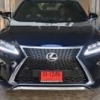Search the Community
Showing results for tags 'pens'.
-
https://asia.nikkei.com/Business/Consumer/A-fine-line-The-evolution-of-the-ballpoint-pen-in-Japan?utm_campaign=GL_JP_update&utm_medium=email&utm_source=NA_newsletter&utm_content=article_link&del_type=4&pub_date=20211030090000&seq_num=19&si=44594 A fine line: The evolution of the ballpoint pen in Japan Complex kanji characters drive demand for slender strokes Ballpoint pens with 0.38 mm tips line the shelves of a Maruzen store in Tokyo. HARUKA HORIBE, Nikkei staff writerOctober 29, 2021 12:00 JST TOKYO -- Even in today's digital society, ballpoint pens remain an essential tool in our daily lives, whether at work or for jotting down our deepest personal thoughts in a journal. In Japan, stationery stores typically carry a huge selection of ballpoint pens. Tip sizes, for example, typically range between 0.5 mm and 0.7 mm, to as little as 0.38 mm. While the sheer number of choices can flummox buyers, it also tells us something about Japan's unique writing instrument culture. The ballpoint pen is a surprisingly new invention, dating back to 1943. The first model used oil-based ink developed by Hungarian inventor Laszlo Biro. Ballpoints came to Japan later, with manufacturers competing to roll out new products. Ohto, a company in Yuki, Ibaraki Prefecture, marketed a pen that used water-based ink in 1964. In 1984, Sakura Color Products in Osaka launched a gel-ink pen that it said allowed people to write smoothly, like water-based ink pens, but whose ink, when dry, offered the water resistance of oil-based ink. In the early days, pen tip sizes ran from 0.8 mm to 1.2 mm. Overseas, bold was best: "People in Europe and the U.S. use signatures a lot, and as they write with Roman letters, they tended to prefer thick lines," according to a spokesperson of the Japan Writing Instruments Manufacturers Association. By contrast, Japanese is written mostly with kanji, as Chinese characters are called. They tend to have many strokes, so thick lines make for messy writing. That led Tokyo-based Zebra to introduce a pen in 1959 with an oil-based ink and a tip measuring 0.7 mm. It later expanded the range of tip sizes to include 1.0 mm and 0.5 mm pens. Although the typical scribbler might think the number refers to the width of the line a pen lays down, it actually indicates the diameter of the tiny roller in the tip that gives the ballpoint its name. The width of the line a pen produces is actually about half the ball's diameter. But not all pens are created equal: The thickness of the line "differs if you use different products, even if they have same tip size, like, for example, a 0.5 mm pen, because the ink quality and the amount of ink flow vary," according to the Writing Instruments Manufacturers Association spokesperson. Although they are both sold as 0.5 mm tip, gel ink ballpoint pens, Mitsubishi Pencil's Uni-Ball Signo's line is 0.3 mm wide, while that of Pilot's Hi-Tec-C is slightly thinner, at 0.25 mm. Line widths also vary depending on whether the ink is oil- or water-based. The top-selling ballpoint pens are those with 0.5 mm and 0.7 mm tips, but in the last few years pen makers have introduced products with smaller and smaller rollers. After Pilot introduced a Hi-Tec-C model with a 0.3 mm tip, rivals followed suit. Making such tiny rollers for pens that use oil-based ink is difficult because of its viscosity, but Mitsubishi Pencil successfully developed a 0.38 mm version of its Jetstream pen, putting it on sale in 2013. "When carbon copies were still used widely, pens with thicker tips were often preferred, but the purpose of [pens'] use in work has shifted. People now use them to make notes in the narrow spaces between the lines of printed materials, or to make notes in a tiny notebook," a spokesperson for Mitsubishi Pencil said. "That led to an increased preference for pens with thinner tips." The 0.38 mm tip size of the Jetstream may seem random, but it is the result of the company's efforts to create a comfortable feel with an oil-ink pen and the optimum balance in line thickness, the spokesperson said. Last year, Mitsubishi Pencil introduced a 0.28 mm version of the Jetstream. The technology for making ballpoint pen tips has advanced to the point where manufacturers can fashion tips that are minuscule yet resist wear and tear, and they are pushing smaller tipped, oil-ink products. Incidentally, young Japanese increasingly prefer 0.3 mm tips for mechanical pencils. Despite growing digitization and a falling birthrate, sales of pens and pencils remain solid in Japan. According to the Japanese Ministry of Economy, Trade and Industry, sales of ballpoint pens totaled about 63.5 billion yen ($559 million) in 2020, an increase of 2.4 billion yen versus a decade ago, although sales of ballpoint pens for office supplies fell over the period, hit by the global financial crisis and the COVID-19 pandemic. But, said Tomoo Ikeda of Zebra's public relations department, "There are increasing numbers of people who buy them for themselves, with their primary focus being design and functionality factors [as an expression of] individuality." Japanese ballpoint pens have a worldwide reputation for quality. Japan exported about 750 million ballpoint pens using water-based ink in 2020. Pilot sells nearly 90% of its ballpoints overseas. "Even as the nation digitizes, people are enjoying analog aspects of things as they seek what is special to them," Zebra's Ikeda said.



